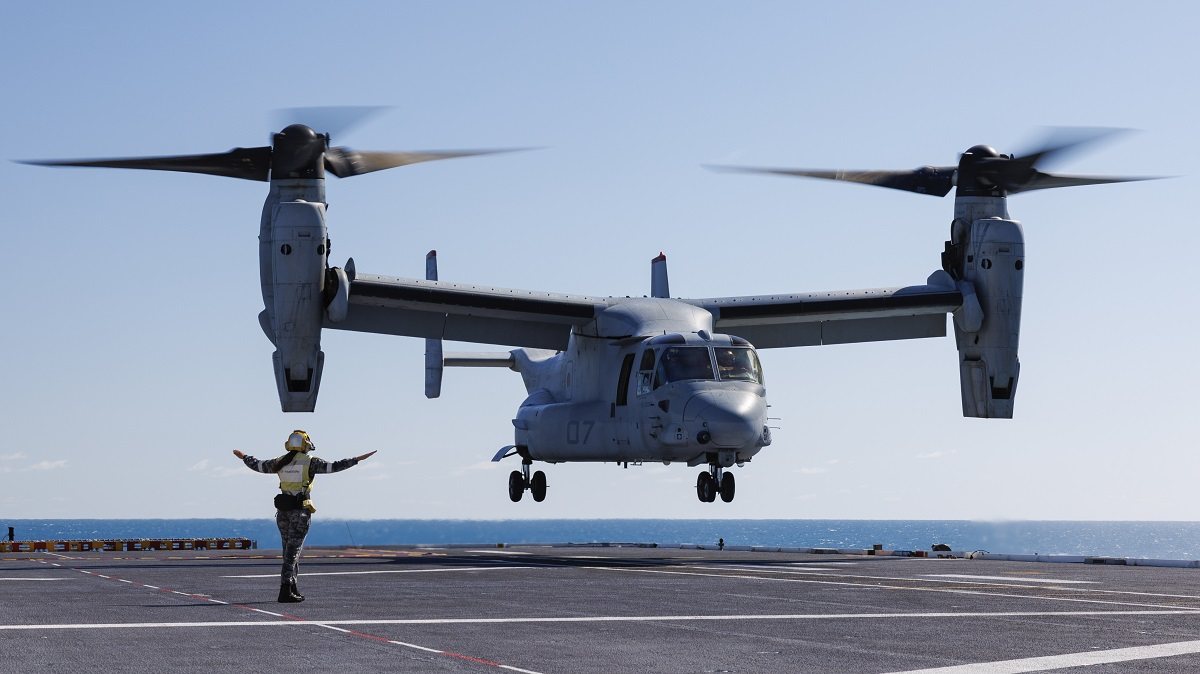Weak Spots in Metal May Have Led to Fatal Osprey Crash off Japan, Documents Obtained by AP Reveal

Royal Australian Navy sailor Leading Seaman Keely Hagedoorn guides a U.S. Marine Corps MV-22 Osprey during take-off and landing practice on the flight deck of HMAS Adelaide in the Whitsunday Islands off the coast of Australia during Exercise Sea Raider, Aug. 7, 2023.
13:46 JST, August 7, 2024
WASHINGTON (AP) — A gear crack that led to a fatal crash of a V-22 Osprey last year may have been started by weak spots in a metal used to manufacture that part, according to documents obtained by The Associated Press.
The November crash killed eight Air Force Special Operations Command service members. It was the second time in less than two years that a catastrophic failure of a part of the Osprey’s proprotor gearbox, which serves as its transmission, caused a fatal accident. In June of 2022, five Marines were killed when a different part of the proprotor gearbox system failed.
The crashes have led to an aggressive effort by the V-22 program office and manufacturer Bell Flight to find fixes for the critical system, which has had some components wear down earlier than the military expected. While investigators still don’t know for certain what caused either crash, this latest finding might hold some clues.
There’s no other aircraft like the Osprey in the fleet. It can speed to a target like an airplane then rotate its engines to land like a helicopter. Program leaders have pointed out that the Osprey has been vital in special operations and combat missions and has flown hundreds of thousands of hours successfully.
But the aircraft also has a troubled crash history, and the proprotor gearbox has been a persistent problem.
Data gathered by The Associated Press through the Freedom of Information Act shows 609 proprotor gearboxes have been removed for repair in the past 10 years. Over the last five years, the Marine Corps, Navy and Air Force have reported 60 incidents involving the proprotor gearbox.
Last week the Air Force identified cracking in a pinion gear, a part that’s about the size of a large jar lid, as one of two factors that caused the crash off Japan. The Air Force also faulted the pilot and crew, because the Osprey sent six warnings during their flight that the proprotor gearbox was in trouble.
But additional crash report documents obtained by the AP show this is not the first time this metal has failed in Osprey proprotor gearbox components, although it was the first time it failed in this specific gear. There have been seven previous cracking incidents in related gears that were likely caused by the same metal weakness, investigators reported.
It’s not clear if that information had previously been shared with the services, which could have led them to take a much more restrictive approach to how pilots were instructed to respond to any proprotor gearbox warnings.
In a rare move, as part of the accident report released publicly last week, the Air Force faulted the V-22’s program office for not sharing data that could have better informed crews of the severity of the risk.
The pinion gears are located inside the proprotor gearboxes on each wingtip. The gearboxes take in power from the Osprey’s engines and process it to turn the Osprey’s masts and rotor blades.
To do that, the gears spin rapidly under extreme pressure. They can overheat and break off metal flakes, called chips, which can move through the transmission and destroy it. Loss of a proprotor gearbox is dangerous and can lead to loss of an aircraft and crew.
In the November crash, investigators believe the first of the six chip warnings was an indication that a crack in the pinion gear had already taken hold and it was fracturing off small metal flakes as it continued to spin. The warnings progressed as the gearing shed more debris and ultimately broke apart, leading to rapidly cascading failures throughout the Osprey’s entire drive system and the fatal crash.
In the supplemental crash documents, investigators said analysis of the recovered pinion gear pieces revealed multiple inclusions. An inclusion is a microscopic weak spot in metal caused by foreign substances getting mixed in during the manufacturing process. Those weak spots can lead to fatigue cracking.
The specific alloy used to manufacture the Osprey’s pinion gears is called X-53 VIMVAR. Crash investigators found multiple inclusions in the failed pinion gear and similar inclusions in a second pinion gear on the aircraft, the report said. While the inclusions were found to be within the microscopic size limits allowed, investigators noted that “initiation of a fatigue crack is dependent on the size of the inclusion and its location within the gear material.”
Investigators concluded they could not determine whether the inclusions led to the cracking. But they left open the question of whether there may have been larger inclusions that could have caused the cracking and were lost as the pinion gear broke apart. “If the pinion did crack due to an inclusion, the evidence was obscured by the secondary damage,” the report found.
Of the 60 incidents reported over the past five years, at least 41 included chipping indications, according to the data obtained by the AP.
The gearbox is a sealed system, meaning ground crews on base can’t open it to inspect the gears for inclusions, and even if they could, they don’t have the machining needed to detect the microscopic defects, Air Force Special Operations Command head Lt. Gen. Michael Conley told the AP in an interview.
“So in the field, there’s nothing we could have done to detect this,” Conley said.
And Bell Flight can’t test the whole gear for inclusions either without multiple cuts into it, which would destroy the part. The primary safeguard is process control during manufacturing, the report said.
It’s not clear whether other Osprey parts, including the input quill assembly that was the cause of the Marine Corps 2022 crash, are also made from the X-53 alloy.
Bell referred all questions on the proprotor gearbox to Naval Air Systems Command, or NAVAIR, which has overall responsibility for the V-22 Osprey program.
In a statement to the AP, Col. Brian Taylor, head of the Pentagon’s V-22 program office, said it could not comment on specific proprotor gearbox changes underway, but said “as improved materials become available, they are evaluated for use in all our systems.”
Conley said, for now, the Air Force has made flying the Osprey more restrictive while doing longer-term engineering analysis. “Figuring out if there’s a better way with the gearboxes, better production methods, better material. That’s with NAVAIR and Bell right now,” he said.
Until at least mid-2025, the Osprey is expected to remain under flight restrictions that require it to stay within 30 minutes of a spot to land, among other safety checks.
Air Force Special Operations Command only has 51 Ospreys, but it’s had to remove 132 proprotor gearboxes for repair in the past 10 years, according to data obtained by the AP. The Marine Corps purchased 360 Ospreys and currently operates about 270. Over the past 10 years it’s removed 464 proprotor gearboxes. The Navy, which has 27 in the fleet, has removed proprotor gearboxes 13 times.
While the Osprey has been in design since the 1980s, the Marine Corps’ MV-22 version has only been deployed since 2007, the Air Force CV-22 since 2009 and the Navy’s CMV-22 version since 2021.
"News Services" POPULAR ARTICLE
-

American Playwright Jeremy O. Harris Arrested in Japan on Alleged Drug Smuggling
-

Japan’s Nikkei Stock Average as JGB Yields, Yen Rise on Rate-Hike Bets
-

Japan’s Nikkei Stock Average Licks Wounds after Selloff Sparked by BOJ Hike Bets (UPDATE 1)
-

Japanese Bond Yields Zoom, Stocks Slide as Rate Hike Looms
-

Japan’s Nikkei Stock Average Buoyed by Stable Yen; SoftBank’s Slide Caps Gains (UPDATE 1)
JN ACCESS RANKING
-

Keidanren Chairman Yoshinobu Tsutsui Visits Kashiwazaki-Kariwa Nuclear Power Plant; Inspects New Emergency Safety System
-

Imports of Rare Earths from China Facing Delays, May Be Caused by Deterioration of Japan-China Relations
-

University of Tokyo Professor Discusses Japanese Economic Security in Interview Ahead of Forum
-

Japan Pulls out of Vietnam Nuclear Project, Complicating Hanoi’s Power Plans
-

Govt Aims to Expand NISA Program Lineup, Abolish Age Restriction

























